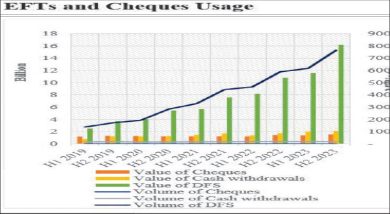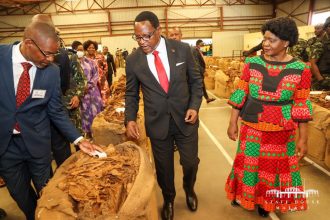2014: Year Malawi to tobacco brought misery

Tobacco, fondly christened Malawi’s green gold, had little breathing space in the just-ended year of 2014. Why? More challenges piled up and pummelled hard the tobacco sector, which continues to dance to the tune of a myriad of global dictates, particularly the World Health Organisation (WHO) and other anti-smoking superpowers.
These global challenges continued to manifest themselves on the domestic front through poor demand for the leaf, low competition among tobacco buyers at the auction floors and poor pricing, among others. As we have entered 2015, that there are little strides for the domestic economy to show off in terms of diversifying away from tobacco. This is also a view shared by the Civil Society Coalition for Tobacco Control in Malawi (CCTC), towards the end of the year.
A leaf with stunted growth
Final statistics summing up tobacco industry performance in 2014 compiled by Tobacco Control Commission (TCC) are enough to conclude that the sector experienced “stunted growth” during the just-ended year in terms of revenue earned at national level. Total earnings are a key indicative variable of tobacco performance, apart from volumes and average weighted prices.
In 2014, Malawi earned $361.5 million (about K174 billion) from the crop compared to total earnings of $361. 6 million (K174 billion) the year before. Tellingly, in percentage terms, the revenue earned between the two successive years did not move even an inch.
But despite such a situation, demand for foreign exchange by Malawians continues to surge. Local manufacturers or producers are now demanding more foreign exchange to import various raw materials and other capital equipment. Reserve Bank of Malawi (RBM) estimates that Malawians are now consuming $191 million (K92 billion) worth of foreign exchange per month, up from $181 million (K88 billion) earlier in the year and $129 million (K62 billion) just a few years ago. Ironically, tobacco, which is Malawi’s major source of foreign exchange, continues to contribute less to Malawi’s foreign exchange buffer.
Other tobacco indicators during the year did well. For instance, total volume sold at auction floors level was 192 million kilogrammes (kg) in 2014, representing 14 percent increase from about 169 million kg sold in 2013. But in terms of pricing, the leaf fetched an average price of $1.88 per kg from an average price of $2.14 per kg in 2013, representing a 12 percent decrease.
Tobacco demand in jeopardy
Tobacco buyers are willing to buy about 190 million kg of tobacco in the next coming season. However, such a figure is less what they demanded in the 2014 season. This is no sweet news to a local grower from Malomo in Ntchisi, who solely depend on tobacco to sustain his livelihood.
In 2014, Malawi’s tobacco trade requirement was pegged at 210 million kg, but tobacco merchants managed to purchase 192 million kg through both contract and auction systems, according to final tobacco sales statistics from tobacco regulator, TCC.
Graham Kunimba, chief executive officer of Tobacco Association of Malawi (Tama), the largest tobacco growers’ body in Malawi, interprets that such a drop in the trade requirements for Malawi tobacco could be in line with the global trend in tobacco business characterised by plummeting demand for the leaf.
He warned that if Malawi would produce its leaf above the said tobacco requirement, it would backfire as prices would certainly be lower, hurting farmers. Malawi’s other tobacco customers across the globe are sitting on uncommitted stocks and these include China, Brazil, India and Russia, according to TCC.
New threat engulf Malawi tobacco
It never rained, but poured for the industry in 2014 in terms of emerging challenges that seem to tenaciously grip the global tobacco sector. Now TCC is also worried with the advent of next generation tobacco products (NGTPs), which it says could eventually reduce demand for genuine tobacco products from Malawi. Today, all major global tobacco manufacturers such as British America Tobacco (BAT), Philip Morris, Japan Tobacco International, Imperial Tobacco and China Tobacco have started manufacturing NGTPs. These include e-cigarettes, smokeless tobacco, tobacco plants for fuels and medical uses as well as blended and heated tobacco products.
The products are manufactured to reduce toxicity arising from tobacco smoking and emanate from the rise in global awareness in health risks associated with tobacco products by World Health Organisation’s Framework Convention on Tobacco Control (WHO-FCTC) and the enactment of anti-tobacco laws across the globe. The products are aimed at replacing leaf-based tobacco products, which Malawi and other countries produce and export.
“These NGTPs could reduce the growing of actual tobacco, low pricing for leaf based tobacco products, contraction of tobacco-based employment, rise in illicit trade in tobacco products. All these mean that farmers’ livelihoods will be affected,” said TCC chief executive officer Bruce Munthali. His worries are echoed by the Economics Association of Malawi (Ecama) president Henry Kachaje, who said the introduction of electronic tobacco-less cigarettes will, in the next few decades, make tobacco growing a non-viable economic activity, especially in countries with very low farm technology like Malawi.
Deafening cries from growers
In 2014, tobacco growers did not relent to express their fustrations in their respective farming endeavours. In fact, with the advent of the integrated production system (IPS) or contract farming, there seem to be a war waged between IPS and auction system proponents. And true to the adage that when two elephants fight, it is the grass that suffers. In this context, it is apparent that it is the grower who is paying the price of such antagonism by key stakeholders in the tobacco industry.
Most tobacco growers are bitterly complaining about high interest rates, exchange rate volatility during the marketing season, punitive deductions from their proceeds, high cost of farm inputs on the market and long duration to get registered at TCC, among other pressing worries. Some of the institutions that benefit from the tobacco levy for their operations include TCC, Auction Holdings Limited (AHL) and Agricultural Research and Extension Trust (Aret). It has taken efforts from the Ministry of Agriculture, Irrigation and Water Development to embark on a task of compiling all challenges facing tobacco growers to address them.
Way forward in 2015 and beyond
Minister of Agriculture Allan Chiyembekeza in an interview said government still banks on tobacco, despite also intensifying the growing of other crops, because it still remains Malawi’s lifeline. The minister said this week that most tobacco growers are still making huge profits from the crop despite encountering severe challenges facing the industry.
“For instance, we heard a farmer, a Chipeta from Chatoloma in Kasungu, who made over K2 million kwacha profit last season and we heard others make profits of over K6 million at club level. “These are stories, which, we as a ministry, need to document as success stories. Yes, there are challenges in the industry and, as a ministry, we will address them,” said Chiyembekeza.
Malawi continues to rely heavily on tobacco, which contributes about half of all foreign exchange revenue in a year, generates about 23 percent of government tax revenue and contributes about 15 percent to the gross domestic product (GDP), among other key economic advantages.





